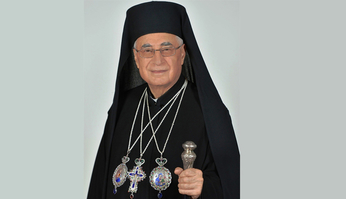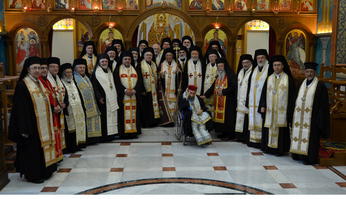Patriarch Youssef
Biographical Notice
8 12 2011
Biographical Notice of His Beatitude Gregorios III Laham Patriarch of Antioch and of All the East, of Alexandria and of Jerusalem of the Melkite Greek Catholic Church
His Beatitude was born in 1933 in Daraya (near the Syrian capital, Damascus) known as the place of St. Paul’s conversion. The young Lutfi (the name means kind) was accepted in 1943 into the seminary of the Salvatorian Fathers at the Monastery of the Holy Saviour near Saida (in southern Lebanon) where he completed his studies in philosophy and theology. He took temporary vows on 15 August 1949 and made his solemn profession on 20 January 1952. His superiors decided to send him in 1956 to Rome (Italy) to further his theological studies. In 1961, he received the title of Doctor in Oriental Ecclesiastical Sciences from the Pontifical Oriental Institute run by the Jesuit Fathers. There he was ordained priest on 15 February 1959 at the Monastery of Grottaferrata (near Rome.)Back in Lebanon after finishing his doctorate in 1961, he was named Superior of the Major Seminary of his Order at Holy Saviour (1961-64); then at Jeita near Beirut (1966-1969.) During that period, he taught theology and liturgy at the Major Seminary and at the University of the Holy Spirit at Kaslik (near Beirut.)Inspired to work for Church unity, he founded in 1962 the review Unity in Faith. This was the first Arabic review dealing with ecumenical issues and problems. Then the Holy Synod of the Melkite Greek Catholic Church named him Secretary of the Ecumenical Commission and of the Liturgical Commission. Further, in 1972 he was able to prepare in Beirut the first Liturgical Congress between the sister Churches (Greek Catholic and Greek Orthodox) of the Patriarchate of Antioch. He continued working with enthusiasm and perseverance for dialogue between the two Churches, becoming a member of ATIME (Association of Theological Institutes in the Middle East.) Subsequently he was invited to conferences and to participate in different congresses in Germany, Italy and England…These responsibilities did not stop this dynamic priest from serving several parishes in Lebanon, where he dedicated himself to teaching and preaching. So he began work on the social level by founding the Girls’ Home (in 1964)with several branches in various villages of the Eparchy of Saida in South Lebanon. Then, in collaboration with Fathers George Kwaiter and Salim Ghazal and the help of some German friends, he set up the Providence Home in 1966 in Salhieh, in the hills east of Saida. This last social project consisted of an orphanage for 100 children and a technical school for 500 students. The home also comprised a centre for young people who wished to dedicate themselves to social, parish and religious activities. Then in 1971 the idea of a centre for Religious Studies for adults was conceived.In 1974, after the arrest of Archbishop Hilarion Capucci by the Israeli authorities, His Beatitude Patriarch Maximos V Hakim appointed him Patriarchal Administrator, then Patriarchal Vicar in Jerusalem.During 1974-75, he completed the projects under way in Jerusalem, including the restoration of the patriarchal residence and the equipment of a pilgrims’ hostel (with accommodation for ninety) that belonged to it; as well as the iconographic frescoes of the cathedral church of Jerusalem.He devoted himself also to creating in 1976 a book-shop specialising in the eastern tradition, with books in several languages. Also in 1976 he founded a centre for religious studies for adults that has now become a branch of the University of Bethlehem. In 1977, he dedicated himself to social service and instituted the Common Financial Fund with the aim of helping Jerusalem’s poorer students to pursue their university studies.The Holy Synod, meeting on 9 September 1981, elected him to the rank of bishop. He was consecrated in Damascus on 27 November of the same year by His Beatitude Patriarch Maximos V, assisted by their Excellencies Saba Yuakim and Francis Abu Mokh. In 1981, he initiated a housing project consisting of 36 apartments to accommodate a number of poor families in Jerusalem, with a church, a large hall and a health centre. This project, completed in 1983, was followed by the construction of several housing projects in Beit Sahour, Taybeh and Ramallah, as well as schools, health centres and restoration of church buildings….In 1986, the Holy Synod appointed him to head the Patriarchal and Synodal Liturgical Commission. He worked on that with perseverance and enthusiasm and with the help of the Liturgical Commission, finished the book of the Divine Liturgy in 1992, adding to the former edition different introductions and variant readings. He continued working to complete the book of Liturgical Prayers in four volumes, a work to make our Church proud of its Byzantine tradition.Besides all that, His Beatitude has written a number of books and articles, some of which have been translated into different languages, such as Introduction to Liturgical Rites and their Symbols in the Eastern Church, The Pastor’s Voice – Eastern Liturgical Spirituality, Life and Theological Work of Archbishop Germanos Adam, A History of the Melkite Church, The Melkite Greek Catholic Church at the Second Vatican Council…In June 2000, he invited all the Catholic Bishops of Byzantine tradition from around the world to a Congress in the Patriarchal Residence of Jerusalem. They were able to study together problems common to their Churches. That was the first time that such a reunion had taken place between the different Byzantine Churches.Incapacitated by old age, His Beatitude Maximos V Hakim retired as Patriarch of the Melkite Greek Catholic Church. The Holy Synod, assembled at Rabweh on 22 November 2000, accepted the Patriarch’s resignation. So, having met again on 29 of the same month, the Synod elected His Eminence Archbishop Lutfi as Patriarch of Antioch and of All the East, of Alexandria and of Jerusalem. He took the name of Gregorios III, a name that means “the watchman.”

